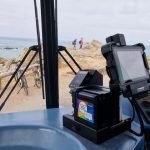MAN continues to develop its coach range. Currently under the spotlight is safety. Cameras in place of mirrors is just one of a small number of changes that the manufacturer says will deliver major benefits
MAN has revealed its strategy for the medium-term progression of driver assistance on both its own brand coaches and the Neoplan range. Safety is at the forefront of them all.
Reducing driver workload is an incremental step on what is a long road to partial automation. MAN believes that self-driving coaches are years away, if they happen at all. But one advance in particular represents a step change.
External mirrors are removed and replaced with cameras. That gives three benefits: It reduces potential for damage, it cuts fuel consumption (and thus TCO), and it also improves safety.
Who’s the fairest of them all?
Rear-view cameras are among a handful of other developments. None are earth-shattering. They are progressive, using existing technology.
One demonstration coach has been equipped with the cameras. It is a Neoplan Cityliner, but Head of Product Marketing Jan Aichinger confirms that the system will be offered optionally on the Tourliner later.
The cameras are within small casings mounted where the mirror arms would otherwise meet the body. Each feeds to a colour LCD screen on the A-pillar, split in the same manner that a conventional mirror set would be; a large standard-aspect view is above a smaller, wide-angle one.
Although lacking from the Cityliner, production installations will include a camera above the windscreen. It will face downwards, giving drivers a view of frontal obstructions.
Extensive validation
MAN accepts that if driver acceptance is to be achieved, then as a baseline the cameras must do everything that mirrors can. To that end, the feed does not pass directly to the screens. It goes via powerful software.
Principally, that is to allow image quality to be high regardless of ambient light. In particular, MAN says that when entering or exiting tunnels, no difference is noticeable. Compensation occurs immediately.
Precautions have been taken to ensure that the driver’s view is maintained with dirt on the lens cover. The software accounts for that by removing distortion. A heater is also within the camera unit to clear ice or fogging.
Should a camera or a screen fail, MAN provides two basic mirror arms to be kept aboard the coach that can be attached easily.
routeone was able to drive the camera-equipped Cityliner. It takes a little getting used to; the screens give a more expansive view than mirrors, and in strong sunlight there remains some work to do to compensate for the darkest shadows.
But the overall impression is remarkable. Adjusting takes a lot less time than may be expected, and within a couple of miles it is second nature. This may be the future.
MAN’s view
Why has MAN developed what could be considered a boondoggle? There are three reasons, says Mr Aichinger. “We have seen fatal accidents involving cyclists or pedestrians when coaches are turning. With cameras, a person can walk from the front to the rear and be visible at all times.” Despite the potential to do so, MAN is not developing automatic braking if an obstruction is detected when turning.
A further reason is to reduce damage. MAN has analysed spare parts sales, and mirror arms are among the fastest-moving items. Operators who have replaced them will know that they are not cheap.
Finally – and a key to a TCO reduction – is small cut in wind resistance. Mr Aichinger says that when combined with removal of mirror arm replacement costs, it contributes to a payback period of under three years.
Other developments
Developing rear-view cameras is not the sum of MAN’s safety-related work. Other innovations are more minor, and they build on existing systems.
Electric steering will be added to integral and chassis-based coaches. In conjunction with the lane departure warning system, a change of direction without signalling will prompt auto-correction unless the steering wheel is held tight.
Lastly, a fatal accident involving a coach where emergency braking was turned off has led MAN to a rethink of the mandatory system’s functionality.
As standard, the on/off switch will be removed, although if the customer insists, it will be retained on coaches built to order.
It’s easy to see that these changes alter the driver’s involvement in how a vehicle behaves. More will inevitably follow. MAN CEO Joachim Drees says that the commercial vehicle industry is evolving at a pace faster than ever before.
Based on his company’s latest innovations and what else it has in store, that change will continue thick and fast – but its endpoint remains unclear.
routeone comment
As with all of the many technological advancements on vehicles in recent years, the key hurdle with MAN’s ‘camera as a mirror’ concept will be driver acceptance.
In the clamour to unveil newer and better assistance systems, sometimes overlooked is the issue that getting to grips with them may pose, particularly to older members of staff who are more accustomed to more basic vehicles.
MAN now recognises that. It has a noticeably less positive attitude towards the bizarre concept of truck platooning, and it calls into question whether there will ever be a fully-autonomous coach in any form.
Perhaps the idea of small and steady incremental improvements is a better long-term strategy that attempting to reinvent the wheel with autonomous vehicles. But as Joachim Drees says, the industry is going through a period of change such that it has never seen. In short, all of these additions will only work as intended if your drivers are familiar with them. alt=”” src=”https://www.route-one.net/wp-content/uploads/match_of_day_final.jpg” />

























